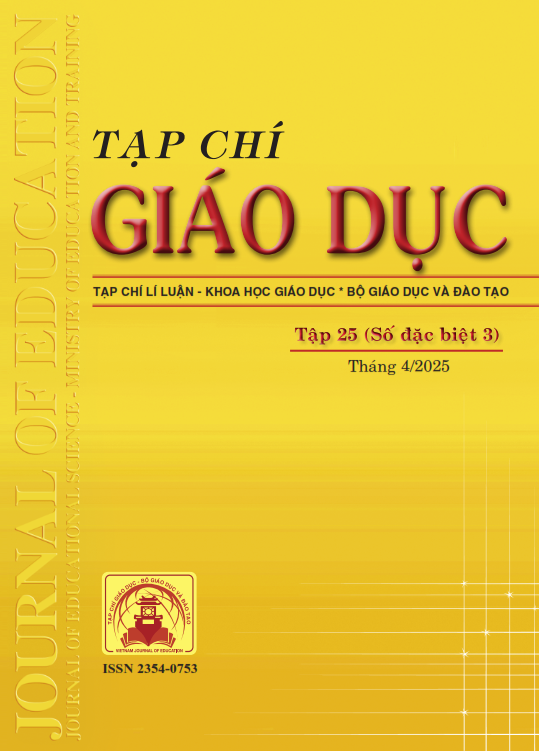Một số mô hình lí thuyết học tập dựa trên thiết bị di động ở trường phổ thông
Tóm tắt
The development of technology has promoted new teaching methods, in which E-Learning plays an important role as a flexible learning method and supports teachers in teaching. Mobile-based learning (M-Learning), an extension of E-Learning, allows learning to take place in many different contexts through social interaction and the use of mobile devices. This method brings both benefits and challenges. The article introduces a number of theoretical models that can be applied in E-Learning and M-Learning, including the SAMR model, the TAM model, the ADDIE model and the ARCS model. Teachers can choose one of these models to design and apply mobile technology in teaching in general schools. Teachers can choose one of these theoretical models to design technology applications on mobile devices to serve teaching activities in general schools.
Tài liệu tham khảo
Bộ GD-ĐT (2020). Thông tư số 32/2020/TT-BGDĐT ngày 15/9/2020 ban hành Điều lệ trường trung học cơ sở, trung học phổ thông và trung học có nhiều cấp học.
Boyatt, R., & Sinclair, J. (2012). Navigating the educational cloud. In Workshop on Learning Technology for Education in Cloud (LTEC'12) (pp. 179-191). Berlin, Heidelberg: Springer Berlin Heidelberg.
Bromley, K. (2012). Using smartphones to supplement classroom reading. The Reading Teacher, 66(4), 340-344.
Cavus, N., & Ibrahim, D. (2017). Learning English using children's stories in mobile devices. British Journal of Educational Technology, 48(2), 625-641.
Cheung, K. S. (2011). Use of IT in Distance and Continuing Education. In Education and IT Conference (Keynote). Euro Events, Hong Kong.
Crompton, H. (2013). The benefits and challenges of mobile learning. Learning and Leading with Technology, 41, 38-39.
Davis, S. G. (1986). Parades and power: Street theatre in nineteenth-century Philadelphia (p. 5). Philadelphia: Temple University Press.
Donnelly Carol (2020). 7 Ways Mobile-Based Education Apps Are Changing How Students Learn. https://www.entranceconsulting.com/7-ways- mobile-based-education-apps-are-changing-how-students-learn/
Dwitiyanti, N., Kumala, S. A., & Widiyatun, F. (2020). Using the ADDIE Model in Development of Physics Unit Conversion Application Based on Android as Learning Media. Formatif: Jurnal Ilmiah Pendidikan MIPA, 10(2). https://doi.org/10.30998/formatif.v10i2.5933
eCycle Best (2012). Smartphones as Tools for Education: Getting Smart With Smartphones. https://www.ecyclebest.com/resources/smartphones-as-tools-for-education
Eshankulovna, R. A. (2021). Modern technologies and mobile apps in developing speaking skill. Linguistics and Culture Review, 5(S2), 1216-1225. https://doi.org/10.21744/lingcure.v5nS2.1809
Evans, E. (2011). Transmedia television: Audiences, new media, and daily life. Routledge. https://www.routledge.com/ Transmedia-Television-Audiences-New-Media-and-Daily-Life/Evans/p/book
Fajrin, C. E., Ningsih, S. W. W., Kartini, Saputra, A., Khoiriyah, U., & Duma, M. (2023). Student and Teacher Collaboration in Developing STEM-Based Learning Modules and Pancasila Student Profiles. JPI, 12(1), 39-49. https://doi.org/10.23887/jpiundiksha.v12i1.52704
Florez, M. A. (1999). Improving adult English language learners’ speaking skills. ERIC Digest. ERIC Document Reproduction, 4(3), 20-32.
Hajati, K., & Amaliah, N. (2022). Teacher’s Delivery Format and ADDIE Model to Adjust the Online Learning System during the Pandemic Period. Indonesian Research Journal in Education, 6(1), 91-104. https://doi.org/10.22437/irje.v6i1.14649
Holzinger, A., Nischelwitzer, A., & Meisenberger, M. (2005). Mobile Phones as a Challenge for m-Learning: Examples for Mobile Interactive Learning Objects (MILOs). Third IEEE International Conference on Pervasive Computing and Communications Workshops. https://doi.org/10.1109/percomw.2005.59
Huang, Y., Hwang, W., & Chang, G. (2010). Guest editorial-innovations in designing mobile learning applications. Educational Technology & Society, 13(3), 1-2.
Kapp, K. M. (2012). The gamification of learning and instruction: game-based methods and strategies for training and education. John Wiley & Sons.
Keller, J. M. (1987). Development and use of the ARCS model of instructional design. Journal of Instructional Development, 10(3), 2-10.
Kukulska-Hulme, A. (2013). Re-skilling Language Learners for a Mobile World. Mobile-assisted Language Learning; The International Research Foundation for English Language Education (TIRF), Monterey, USA.
Looi, C., Seow, P., Zhang, B., So, H., Chen, W., & Wong, L. (2010). Leveraging mobile technology for sustainable seamless learning: a research agenda. British Journal of Educational Technology, 41(2), 154-169.
Muntean, C. H. (2011). EcoLearn: Battery power friendly e-learning environment for mobile device users. Lambert Academic Publishing.
Nguyễn Thị Duyên (2023). Đánh giá tình hình chuyển đổi số tại các cơ sở giáo dục đại học ở Việt Nam thông qua mô hình SAMR. Tạp chí Nghiên cứu Tài chính kế toán, 245, 43-47.
Patokorpi, R., Tétard, F., Qiao, F., & Sjövall, N. (2007). Learning objects to support constructivist learning. In K. Harman et al. (Eds.), Learning objects: applications, implications, and future directions (pp. 187-222). Santa Rosa: Informing Science Press.
Puentedura, R. R. (2011). SAMR: Moving from enhancement to transformation. http://www.hippasus.com/ rrpweblog/archives/000095.html
Stockwell, G., & Hubbard, P. (2013). Some emerging principles for mobile-assisted language learning. Monterey, CA: The International Research Foundation for English Language Education. http://www.tirfonline.org/english-in-the-workforce/mobile-assisted-language-learning
Swan, K., Kratcoski, A., & van't Hooft, M. (2007). Highly mobile devices, pedagogical possibilities, and how teaching needs to be reconceptualized to realize them. Educational Technology, 47(3), 10-12.
Vavoula, G. , & Sharples, M. (2009). Meeting the challenges in evaluating mobile learning: A 3-level evaluation framework. International Journal of Mobile and Blended Learning, 1(2), 54-75.
Venkatesh, V., & Davis, F. D. (2000). A theoretical extension of the technology acceptance model: Four longitudinal field studies. Management Science, 46(2), 186-204. https://doi.org/10.1287/mnsc.46.2.186.11926
Đã Xuất bản
Cách trích dẫn
Số
Chuyên mục
Giấy phép

Tác phẩm này được cấp phép theo Ghi nhận tác giả của Creative Commons Giấy phép quốc tế 4.0 .












